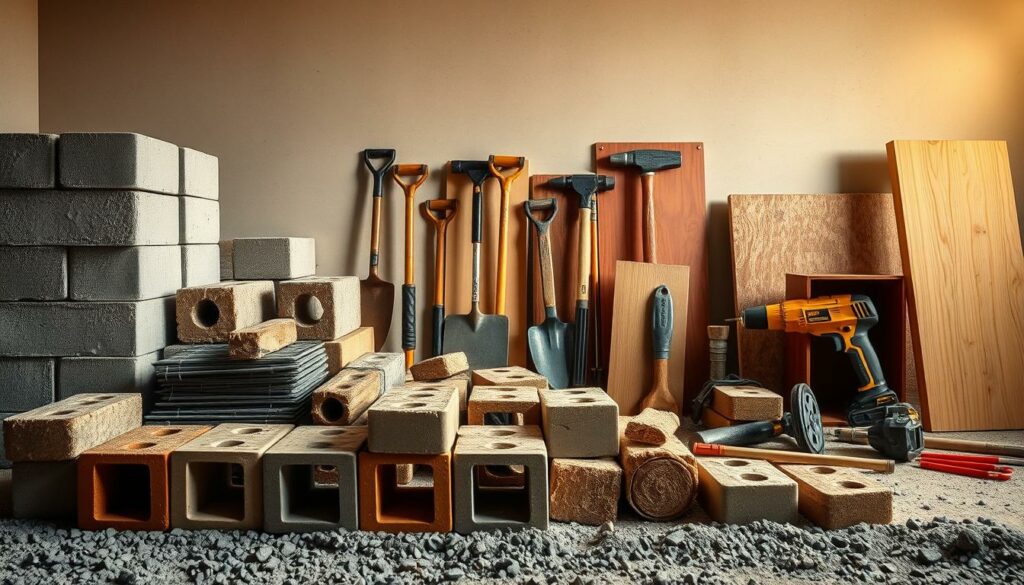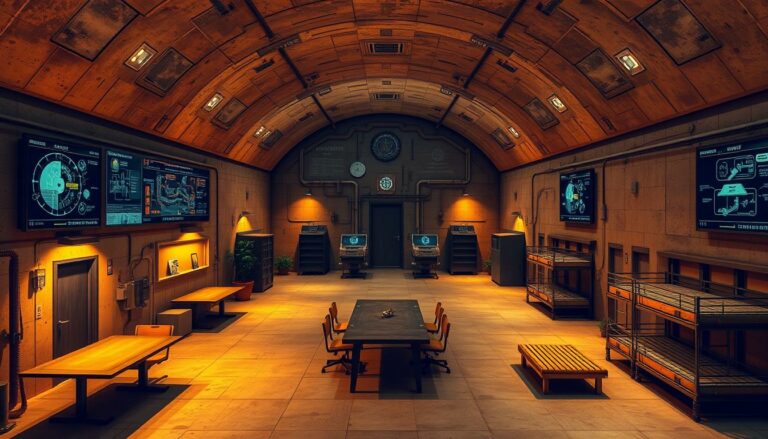Many people worry about nuclear threats, making fallout shelters a key concern. It’s vital to focus on designs that protect families. This article covers the best ways to build shelters that can handle nuclear fallout.
It looks at historical lessons, modern needs, and new materials. You’ll get tips to keep your family safe and ready for emergencies.
With dangers like nuclear accidents and conflicts, a strong shelter is a must. A nuclear blast can start fires up to 20 miles away. This shows how important a well-built shelter is.
A basic shelter for four people is about 10 × 10 × 10 feet. It needs good radiation shielding and air systems for safety during emergencies.
Key Takeaways
- Effective fallout shelter design is critical for radiation protection and emergency preparedness.
- A nuclear weapon’s thermal pulse can ignite materials up to 20 miles away.
- Basic fallout shelters should ideally be 10 × 10 × 10 feet for four occupants.
- Ensure at least 36 inches of soil cover for optimal radiation shielding.
- Stock shelters with enough supplies to last from 3 days up to a month.
Understanding the Need for Fallout Shelters
Fallout shelters are now more important than ever. They were once symbols of the Cold War. Now, they are key to protecting us from nuclear fallout.
Historical Context of Fallout Shelters
During the Cold War, these shelters were vital. They were built for leaders and military personnel. The U.S. had Project Greek Island and Cheyenne Mountain bunker.
In the U.S., President Kennedy’s call in 1961 led to more shelters. Despite doubts, they were seen as a way to prepare for nuclear war. Countries like Switzerland and Sweden also built many shelters.
Modern Threats Leading to Shelter Design
Today, the world is different. New nuclear weapons and threats mean we need better shelters. Shelters now aim to protect against stronger blasts.
Places like Bosnia’s Željava Air Base show shelters that can take direct hits. Switzerland’s law requires new homes to have shelters. This shows how important shelters are for safety.
Creating strong fallout shelters means understanding new threats. It’s about making sure we can protect ourselves from nuclear dangers.
Key Features of Effective Fallout Shelters
Creating a good fallout shelter is key to keep people safe from nuclear threats. It must have radiation shielding, air filters, and support sustainable living. These features make a shelter better at protecting its people.
Radiation Shielding Materials
Good shelters use strong materials to block radiation. They often have thick concrete walls or lead. This is because radiation from a big nuclear blast can travel far.
For example, a blast at ground level can harm people up to 50 miles away. Using materials like concrete and lead is important. It helps keep radiation levels down.
Too much radiation can be very harmful. It can cause sickness or even death. Natural sources also give us some radiation, so shelters need to block more.
Ventilation and Air Filtration Systems
Shelters need good air systems to keep the air clean. These systems remove harmful particles from the air. This is important because the first 24 hours after a blast are the most dangerous.
Having a good air filter helps people breathe safely. It also makes the shelter a healthier place to live. This is part of living sustainably.
Water and Food Storage Solutions
Storing water and food is vital for survival in a shelter. Having enough supplies can last for weeks. Shelters like the T10 tornado shelters have enough water for 48 hours.
Choosing the right foods and using space wisely is important. This helps people stay safe and healthy for a long time. It’s also important because the first fallout is the most dangerous.
“Destruction would be less severe at 5 miles, with significant hazards from fires and early fallout.”
Adding these features to shelters makes them safer and promotes sustainable living. Using the right materials and systems helps shelters be a reliable safe place in a nuclear disaster.
| Feature | Importance | Examples |
|---|---|---|
| Radiation Shielding Materials | Minimizes radiation penetration and exposure | Thick concrete walls, Lead linings |
| Ventilation and Air Filtration Systems | Ensures breathable air quality | HEPA filters, Sophisticated air purification |
| Water and Food Storage Solutions | Supplies sustenance for extended periods | Non-perishable food, Ample water storage |
Choosing the Right Location for Your Shelter
When planning a fallout shelter, picking the right spot is key. A good location can mean the difference between life and death. You need to think about whether to build above or below ground, how close to danger zones, and how easy it is to get in and out.
Above Ground vs. Underground Options
Choosing between above-ground and underground shelters depends on several factors. Underground shelters are better at blocking radiation because of the earth. But, above-ground shelters might be easier to build in flood-prone areas. Using strong materials like concrete and steel can help protect both types, even in earthquake-prone areas.

Proximity to High-Risk Areas
It’s important to pick a spot far from nuclear targets and danger zones. Places like Seattle are at higher risk because of their population and strategic importance. It’s a balance between being close to resources and far from danger. Maps from doomsday preppers can help find safe shelter locations.
Accessibility and Egress Planning
It’s critical to plan how people will get in and out of the shelter. Having multiple exits is important for quick entry and exit. Also, think about ventilation systems to keep air clean, and get the necessary permits. Stock up on emergency supplies like first aid kits and flashlights for safety.
| Key Factor | Recommendation |
|---|---|
| Shelter Size | Minimum of 10 square feet per person |
| Protective Material | Concrete with steel reinforcements |
| Food Storage | At least 2 weeks per person |
| Accessibility | Multiple exits for rapid evacuation |
| Ventilation | HEPA filters in urban areas |
| Construction Permits | Required in many Washington counties |
Shelter Size Considerations
When planning a fallout shelter, size is key. It affects how well the shelter works and how comfortable people will be. Good dimensional planning means the shelter can fit your whole family. It also makes sure there’s enough room for everything you need.
Accommodating Family Size
First, figure out how much space you need. A good rule is about 20 square feet per person for basic needs. Most bomb shelters are made for four people, so planning is important. Builders say you need at least three feet of earth above the shelter for safety.
Creating Space for Supplies
Having enough room for supplies is essential. Make sure you have space for supplies for 72 hours, two weeks, and three months. Use big containers of water instead of small bottles. For waste, use five-gallon buckets with heavy trash bags. Good dimensional planning keeps things organized and easy to find.
Comfort vs. Necessity
Finding a balance between comfort and what you really need is important. Make sure there’s enough air, and ventilation systems work well. Aim for at least five cubic feet per minute of air per person. Design your shelter with both survival needs and comfort in mind, like multi-purpose areas and smart space maximization ideas.
Design Principles for Fallout Shelters
Creating a fallout shelter needs focus on space use, functional areas, and mental health. Using space wisely is key to comfort during long stays. It makes the shelter more useful.
Space Efficiency
Good fallout shelters use space well. In 1961, Congress spent over $169 million (more than $1.7 billion today) on shelters. This shows how important it is to use every inch.
A shelter for four is 10 ft x 10 ft x 10 ft. Adding 3 ft for each extra person is smart. This means we need smart storage and furniture to make the most of every inch.
Multi-Purpose Areas
Ergonomic design is essential. Multi-use areas are vital in shelters. They can have foldable beds and tables that hide away during the day.
Good planning means every item has a place. This includes a ventilation pump that’s 20 inches wide and 36 inches tall. It helps keep air moving.
Psychological Comfort
Mental health in shelters is just as important as physical safety. Long stays can be hard on the mind. So, designs that help mental health are key.
Open spaces and good lighting help reduce stress. FEMA’s 1983 handbook on radiation safety shows the importance of mental health. Adding natural light and areas for relaxation helps keep minds healthy.
Construction Materials for Fallout Shelters
Choosing the right materials is key for a good fallout shelter. We’ll look at the pros and cons of concrete and steel. We’ll also talk about insulation and how to balance cost and durability.
Reinforced Concrete vs. Steel
Reinforced concrete and steel are top choices for shelters. Concrete is great for protecting against blasts and radiation. It absorbs blast energy well, making it durable for a long time.
Steel, on the other hand, is strong against pulling forces. It lets for creative designs. But, steel might need extra insulation to keep up with concrete’s heat control.
Insulation Options
Good insulation keeps the shelter’s temperature stable and blocks radiation. You can use polyurethane foam, fiberglass, or mineral wool. Polyurethane foam is top for keeping warm or cool.
Fiberglass is cheaper and simple to put in. Mineral wool adds insulation and fights fires. It helps the shelter last longer.
Cost vs. Durability Factors
When picking materials, weigh cost against durability. Concrete is pricier but lasts longer and needs less upkeep. Steel is cheaper upfront but might cost more later due to rust and insulation needs.

Emergency Preparedness Plans
Being ready for a radiation emergency can save lives. Knowing how to use survival kits, having good emergency communication tools, and staying trained are key. These steps help you prepare well for such events.
Assembling a Shelter Kit
A good shelter kit is essential for any emergency plan. Important items for survival kits include:
- 7 to 10 days’ worth of non-perishable food and bottled water
- Medical essentials, including first aid supplies
- Battery-powered or hand-crank AM/FM radios for emergency communication
- Flashlights and extra batteries
- Warm clothing and blankets
- Personal hygiene items
- Important documents and contact information
Communication Tools and Devices
Having the right emergency communication tools is critical. They help when modern systems fail. Recommended devices are:
- Battery-powered AM/FM radios to receive emergency broadcasts
- Two-way radios for family and friend communication
- Mobile phones with backup power banks
- Signal flares and whistles for location signaling
These tools keep you connected when newer systems are down. They ensure you stay informed and can communicate when needed.
Regular Drills and Training
Practice is key for preparedness training. Families should do regular drills. This ensures everyone knows the emergency plans and how to react. Important steps include:
- Identifying shelter-in-place locations within the home
- Running timed drills to practice moving quickly to the shelter area
- Reviewing and updating the emergency plan regularly
- Practicing the use of all survival kits and communication tools
By following these steps and planning well, you can boost your readiness and confidence during a crisis.
Maintaining Your Fallout Shelter
Keeping your fallout shelter in good shape is important. You need to check it often, update supplies, and control moisture to stop mold.
Regular Inspections and Upkeep
It’s important to check your shelter regularly. Look for damage, wear, and make sure systems like ventilation work. You should also do maintenance tasks like:
- Inspecting walls and ceilings for cracks or dampness.
- Testing air filtration and ventilation systems.
- Ensuring the integrity of sealing edges and doors.
In Maryland, with almost 1,000 fallout shelters, regular checks are a must. This keeps your shelter safe and reliable for a long time.
Updating Supplies and Equipment
It’s important to manage your supplies well. Change food and water to avoid it going bad. Also, test things like radios and flashlights often.
| Supplies | Recommended Update Frequency |
|---|---|
| Non-perishable Food | Every 6-12 months |
| Water | Every 6 months |
| Medical Supplies | Every 12 months |
| Batteries & Emergency Tools | Check monthly |
Shelters vary across states, from Detroit to Oklahoma City. So, it’s important to keep your equipment and supplies in top shape.
Addressing Mold and Moisture Issues
Stopping mold is key to keeping your shelter safe. Look for leaks, use dehumidifiers, and make sure it’s well-ventilated. This is very important in places with changing weather.
Being aware and taking action is vital for your shelter. By focusing on maintenance, supplies, and controlling moisture, you’ll have a strong shelter ready for emergencies.
Community Involvement in Shelter Building
Getting the community involved in building shelters is key to keeping everyone safe. It’s all about planning together, working as a team, and sharing what we have. This teamwork is what makes shelter projects successful.
Group Shelters vs. Individual Shelters
There’s a big debate about whether to build group shelters or individual ones. Group shelters can hold lots of people, which helps spread out the load. For instance, Denver planned to shelter over 900,000 people during the Cold War.
This way, everyone felt safer and more united. It showed how important it is to work together in tough times.
| Factor | Group Shelters | Individual Shelters |
|---|---|---|
| Capacity | High | Low |
| Resource Sharing | Effective | Limited |
| Cost | Shared | Individual |
| Community Spirit | High | Low |
| Maintenance | Shared Responsibility | Individual Responsibility |
Local Government Resources
Local governments are vital in planning for fallout shelters. In the 1960s, President Kennedy asked for $207 million to help. Cities like Denver found shelters that could protect thousands, showing smart use of resources.
These efforts teach us how to plan today. They show how important government support is for safety and following rules.
Building Codes and Regulations
Following building codes is critical for shelter projects. In the 1960s, nearly one-third of shelters had the right supplies. This ensured they were safe and ready for emergencies.
Today, we must stick to these codes to make shelters effective and legal. This history teaches us about the importance of teamwork and following rules in building shelters.
It shows how community planning and following rules are key to keeping families safe in cities. It’s all about working together and following the law to protect everyone.
Real-Life Examples of Effective Fallout Shelters
Learning from the past helps improve today’s shelters. This section looks at shelter case studies and innovative shelter solutions. These examples teach us valuable historical lessons for designing and building shelters now.
Historical Case Studies
The Las Vegas Underground House is a key example from the ’70s. It was built to keep a family safe for a year. It has a huge underground area, a backup generator, and lots of water.
The National Fallout Shelter Survey and Marking Program was a big effort during the Cold War. It aimed to protect 50 million Americans. In 1962, signs started appearing in 14 U.S. cities. New York City alone had 105,244 buildings checked, with 19,000 marked as shelters.
Modern Innovations in Shelter Design
Learning from the past helps create better shelters today. Modern designs aim for safety and comfort. The Las Vegas Underground House shows how shelters can be luxurious and functional.
New building methods focus on being green and saving energy. Shelters now use renewable energy, advanced water systems, and multi-use areas. This makes them safer and more comfortable during emergencies.
By studying shelter case studies and historical lessons, we can make shelters better. They offer protection and comfort, meeting today’s needs while learning from the past.
Resources for Fallout Shelter Planning
Planning a fallout shelter requires a lot of knowledge. There are many educational materials and guides to help you make smart choices. These resources ensure your shelter is safe and secure for your family.
Recommended Reading and Websites
Many trusted sources offer great advice on building shelters. FEMA has guides like FEMA P-361 and FEMA P-320 for safe room construction. The International Code Council (ICC) also has the ICC 500 standard for storm shelters.
Mitigation Assessment Team (MAT) reports share lessons from big weather events. These insights are key for building shelters.
Professional Consultation Services
Need expert advice? Many companies specialize in fallout shelter design and building. Northwest Shelter Systems, for example, has over 25 years of experience. They help from the start to the end of your project.
Getting professional help ensures your shelter is safe and strong. This gives your family the best protection.
DIY Resources and Guides
If you like to do things yourself, there are many DIY resources and guides. Websites and books offer step-by-step instructions on important topics like radiation shielding and ventilation.
It’s important to know about systems like NBC filtration, power, and water. With the right materials and planning, you can build a strong shelter yourself.
FAQ
What are the primary features of an effective fallout shelter?
A good fallout shelter needs thick walls or lead lining for radiation protection. It also needs air filters and storage for water and food. These features help keep people safe and alive.
How did fallout shelters originate and why are they relevant today?
Fallout shelters were first used during the Cold War to protect against nuclear threats. Today, they’re important again because of global tensions and new nuclear tech. They’re key for keeping us safe now.
What are the best materials for radiation shielding in fallout shelters?
The top materials for shielding are thick concrete and lead. They block radiation well, keeping people safe inside.
Should a fallout shelter be built above ground or underground?
Both above and underground shelters have good points. Underground ones protect better from blasts and radiation. But above-ground ones are easier to build and get to. It depends on what you need and where you are.
How far should a fallout shelter be from possible nuclear targets?
Shelters should be far from cities and military bases. This helps reduce the risk of getting hit by nuclear fallout.
What space considerations are important in fallout shelter design?
It’s important to think about family size and space for supplies. A well-designed area can also help with stress during emergencies.
How can space efficiency be maximized in a fallout shelter?
Use foldable furniture and plan space wisely. Design areas that can change use. This makes the most of the space in a shelter.
What construction materials are recommended for fallout shelters?
Use strong materials like reinforced concrete and steel. Don’t forget insulation for keeping warm and protecting from radiation.
What essential items should be included in a fallout shelter kit?
A good kit has tools, communication devices, and water purifiers. It should also have food that won’t spoil, medical supplies, and hygiene products.
How important are regular drills and training for shelter preparedness?
Drills and training are very important. They help families react fast and safely in emergencies. This makes everyone safer.
What maintenance activities are essential for fallout shelters?
Regular checks and updates are key. Also, keep moisture out and prevent mold. This keeps the shelter safe and working well.
How can community involvement enhance fallout shelter projects?
Community help offers benefits like resources and support. It also ensures shelters meet safety standards. This helps everyone stay safe together.
What can be learned from historical fallout shelters?
Old shelters teach us about good design and building. New tech can make shelters safer and more comfortable for us today.
Where can I find resources for planning and constructing a fallout shelter?
Look for books, websites, and experts for advice. There are also DIY guides to help you plan and build a shelter.
Source Links
- https://www.wikihow.com/Build-a-Fallout-Shelter
- https://www.battlbox.com/blogs/outdoors/how-to-build-a-nuclear-fallout-shelter-a-comprehensive-guide?srsltid=AfmBOoqBlU8w_Haw80La03R5gcd8oxFLKletFgkIdCqR3BjhiOXyifx4
- https://en.wikipedia.org/wiki/Fallout_shelter
- https://home.howstuffworks.com/home-improvement/household-safety/fallout-shelter2.htm
- https://www.dahp.wa.gov/sites/default/files/Fallout Protection What to Know and Do.pdf
- https://remm.hhs.gov/nuclearfallout.htm
- https://utahsheltersystems.com/shelter-types/
- https://www.caringrealestate.com/blog/essential-guide-to-building-a-safe-fallout-shelter-in-washington-state/
- https://www.newsweek.com/map-shows-america-nuclear-war-fallout-shelter-locations-2002103
- https://www.rjpotteigerinc.com/blog/tips-for-building-a-bomb-shelter/
- https://apps.dtic.mil/sti/tr/pdf/ADA382513.pdf
- https://www.orau.org/blog/museum/the-history-of-fallout-shelters-in-the-united-states.html
- https://www.hardenedstructures.com/bomb-shelters/
- https://www.businessinsider.com/cheap-diy-underground-bunker-fallout-shelter-2023-5
- https://www.ready.gov/radiation
- https://emergency.lacity.gov/la-hazards/preparing-nuclear-incidents
- https://ready.alaska.gov/Documents/Fact Sheet – Preparing for A Nuclear Attack.pdf
- https://trueprepper.com/fallout-shelters/
- https://www.nps.gov/articles/coldwar_civildefense_kennedyrockefellerandcd.htm
- https://www.coloradonuclearatlas.org/brief/cold-war-culture-and-the-fallout-shelter/legacies
- https://shelterprojects.org/
- https://www.newsweek.com/underground-home-nuclear-fallout-shelter-1675286
- https://www.history.com/news/nuclear-fallout-shelters-were-never-going-to-work
- https://www.fema.gov/emergency-managers/risk-management/building-science/safe-rooms/resources
- https://www.northwestsheltersystems.com/resources/

